#papier bamboo
Explore tagged Tumblr posts
Text
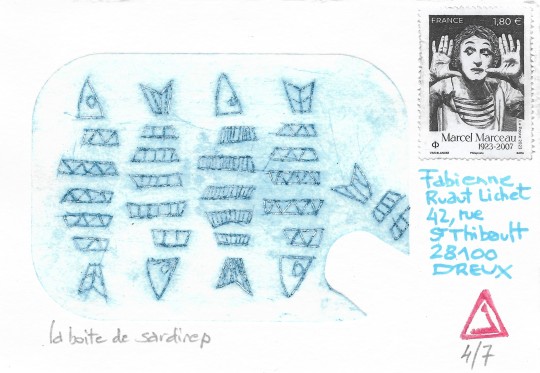
Jonas - 2024 #13 - art postal pour Fabienne - la boite de sardines
gravure sur aluminium - sur couvercle d'une boite de sardines - encre taille douce "Charbonnel" bleu de prusse - 10x14 - papier bamboo 90 % / coton 10 %
réalisation Jonas - 03 -2024
———————————————————————–
contacts et renseignements : [email protected]
————————————————————————
#Jonas#2024#papier / impression & Cie#résister#projet artistique#art postal#mail art#gravure originale#gravure sur aluminium#engraving#Fabienne#papier bamboo
1 note
·
View note
Text
Ancient yelllow paper making techniques
79 notes
·
View notes
Text

Vos papiers sont en règles. Dans la série « Les Gendarmes » par Jenfèvre et Olivier Sulpice, aux éditions Bamboo. - source Une page de BD d'humour par jour.
10 notes
·
View notes
Text
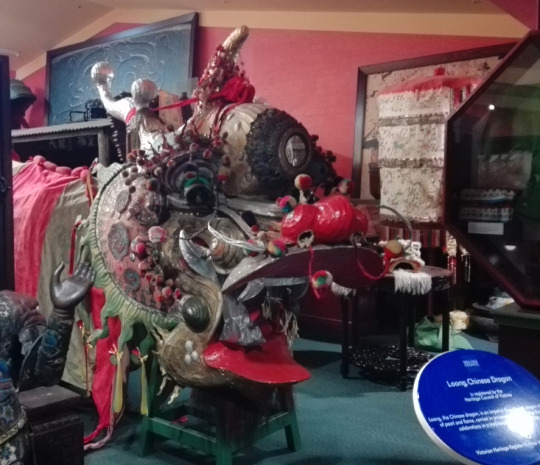

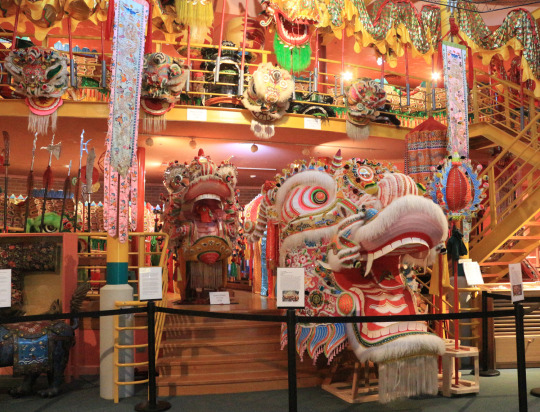


Processional dragons at the Golden Dragon Museum in Bendigo, Victoria, Australia: 1. Loong; 2. Sun Loong, Loong's successor, now also retired; 3. Sun Loong (L) and the new dragon Dai Gum Loong (R); 4. Yar Loong, night dragon; 5. "Bendigo Easter Festival - 1979", painting of Sun Loong by Charles William Bush.
From the museum website (http://www.goldendragonmuseum.org/our-collection/#loong-conservation-project):
"Loong 龍
Loong is the oldest intact processional dragon in the world. He made his first processional appearance in 1901 and was the star attraction of Bendigo’s annual Easter parade until his retirement in 1970. He was created by the Sing Cheung 勝昌 workshop in the city of Foshan (Fatshan) on the Pearl River near Guangzhou (Canton) in southern China. Loong was constructed from silks, mirrors, bamboo, kingfisher feathers, and papier-mache. His name simply means ‘dragon’ but historically he was also referred to by the Chinese community as Gum Loong 金龙 (Golden Dragon) and Moo Loong 舞龍 (Dancing Dragon)
During his parading career Loong made several important appearances outside of Bendigo, most notably at the May 1901 procession in Melbourne to welcome m the Duke and Duchess of York who had come to open the first Australian parliament – a century later he also appeared in the Melbourne parade which marked the centenary of the achievement of Australian Federation. In 2007 Loong was placed on Victoria Heritage register due to his historic and cultural significance. Loong last paraded in the Easter parade of 2019 when he joined Sun Loong 新龍 (new Dragon) and Yar Loong 夜龍 (night Dragon) to welcome Dai Gum Loong 大金龍 (The Great Golden Dragon) to Bendigo.
Loong requires 22 carriers and is 29 meters long. His head weighs 21kg"
Yar Loong: "Translucent, as though made from gossamer, this 80-year-old lantern dragon comes from Hong Kong’s famed Kum Yuk Lau workshop. Abandoned by a Sydney group, Yar Loong first appeared at the Bendigo Easter Parade in 1939. Severely damaged in a fire, he was furloughed and only rediscovered in the 1970s then restored in 1996; he is beloved." (Source: https://zolimacitymag.com/the-immigrant-dragons-part-iv-generations-united-in-bendigo/)
Ballarat has a slightly older but not fully intact Loong: https://www.abc.net.au/news/2023-01-21/ballarat-processional-dragon-loong-celebrated-lunar-new-year/101858398
and the See Yup temple in Melbourne has the head of the other dragon that paraded in the 1901 Federation celebrations: https://museumsvictoria.com.au/article/melbourne-mystery-dragon/
#dragons#mythical creatures#chinese art#processional dragon#parade dragon#my photo#bendigo#australia#chinese culture#heritage#tradition#history
2 notes
·
View notes
Photo
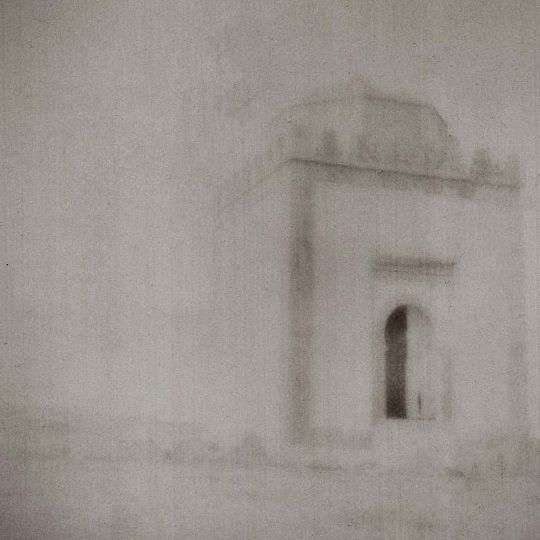
Dans la brume de Cap Beddouza , série Le grain de beauté du Saint . Tirage fine-art issu d’un Polaroïd SX70 . 80x80 cm sur papier Kozo Awagami Murakumo naturel, édition 2/3 40x40 cm sur papier Kozo Awagami Murakumo naturel 15x15 cm sur papier Bamboo . . Exposition à découvrir sur la Mezzanine de la Galerie 127 Marrakech . #morocco #maroc #polaroid #sx70film #photographie #mystic #saint #legraindebeautedusaint #femmephotographe #marrakech @galerie127 @isabelle_ehrler . . Galerie 127 Marrakech Mardi-samedi Horaires ramadan de 11h à 16h (à Galerie 127) https://www.instagram.com/p/CqdNvL-oT4f/?igshid=NGJjMDIxMWI=
#morocco#maroc#polaroid#sx70film#photographie#mystic#saint#legraindebeautedusaint#femmephotographe#marrakech
6 notes
·
View notes
Text
Indian Art Forms

1. Andhra Pradesh -
Kalamkari means, “pen-art”. Kalamkari paintings are either hand painted or block printed on cotton fabric. This art form flourished under the rule of the Golconda Sultanat. It was first developed and evolved at Machilipatnam in Andhra Pradesh but its popularity soon spread to the other states. As far as the popular belief goes, in olden days, groups of artisans, musicians and singers known as chitrakattis would travel from village to village and narrate tales of Hindu mythology. As time passed, they even started illustrating these stories on canvas and thus Kalamkari was born.
2. Arunachal Pradesh - Thangka
A thangka, also known as tangka, thanka or tanka is a painting on cloth. The literal translation of the Tibetan word THANG KA means ‘recorded message’. Among all the art and crafts in Tawang, painting occupies a very special position. Not only it is essential for designing, decorating and finishing many mundane objects, but it is also a highly developed and important means of religious expression. It is a medium through which the Buddhist philosophy can be explained. Thanka paintings have a powerful and forceful impact on most people when they first encounter it.
3. Assam - Assamese Scroll Painting
Manuscript painting in Assam is part of a rich cultural heritage of Assam and India. It grew during the medieval period through the institution of satras. It was influenced by many painting forms and was used to preserve and spread knowledge through the satras and also in the wider society.
4. Bihar - Madhubani
These paintings find their origins and derive their name from a village called ‘Madhubani’ in Bihar. These paintings were first painted by the artists hailing from this village. King Janakraj, father of Sita wanted the artists to capture moments of Sita’s wedding ceremony with Lord Ram. Hence, these paintings came to be known as ‘Mithila’ Paintings. Predominately, the themes revolve around mythology, Hindu Gods and various royal court scenarios.
youtube
5. Chhattisgarh - Godna
The practice of tattooing is widely prevalent across Chhattisgarh. It is a form of body art practiced mostly by women on women, mainly amongst adivasi and 'lower' caste communities from this region. The word used for this practice is godna, which refers to the piercing of the body with needles
6. Goa - Folk Painting
The local handicrafts of Goa truly make for colourful souvenirs. From intricate wood carving to colourful wooden lacquerware, from sturdy bamboo craft to delicate papier-mâché, from fabulous terracotta and brassware to art pieces made from exotic sea shells, from intricate crochet and embroidery to rustic jute macramé, from delicate fibre craft to unconventional coconut masks, Goa’s art forms are as varied and colourful as the land itself.
7. Gujarat - Pithora Painting
Pithora paintings are highly enriched folk art culture of Gujarat done on the walls by several tribes such as the Rathwas and Bhilalas who live in the central Gujarat, 90 km (56 mi) from Vadodara, in a village called Tejgadh. Pithora paintings are more of a ritual than an art form.
8. Haryana - Sculpture
Sculpture, an artistic form in which hard or plastic materials are worked into three-dimensional art objects are famous in Haryana.
9. Himachal Pradesh - Kangra Painting
Kangra painting is the pictorial art of Kangra, named after Kangra, Himachal Pradesh, a former princely state, which patronized the art. It became prevalent with the fading of Basohli school of painting in mid-18th century, and soon produced such a magnitude in paintings both in content as well as volume, that the Pahari painting school, came to be known as Kangra paintings.
10. Jammu and Kashmir - Basholi
Basholi painting is a reputed school of miniature paintings known for its vivid, evocative colors, bold lines, and deep-set facial patterns. This style of painting saw its best years in the 17-18th century. Basholi (Basoli) is a town in Kathua district in the state of Jammu and Kashmir, India.

11. Jharkhand - Sohrai and Khovar Painting
Sohrai art is now known as the state art of Jharkhand. Railway stations in the towns like Hazaribagh and Jamshedpur now greet travellers with Khovar and Sohrai murals that only adorned village homes until recently. Sohrai paintings are age-old tribal traditional paintings based on nature themes – forest, people and animals etc. The paintings are done by tribal women using natural ingredients such as different shades of clay and charcoal.
12. Karnataka - Chittara
Chittaras are intricate wall paintings traditionally created by the tribal women of Malnad on their red mud-coated houses, as well as rangoli floor designs. The traditional paddy husk kalash can be found painted with chittara art, as can papier mache and terracotta vases.
13. Kerala - Kalamezhutgu
Kalamezhuthu is an ancient art woven into the ritualistic mores of Bhagavati, Naga and Ayyappa temples in Kerala. It refers to the pictorial representation of deities on the floor (kalam) using coloured powders (kolappodi) during ceremonies.
14. Ladakh - Thangka Painting and Mural
Religious Art, Early 20th century, From the collection of: Dastkari Haat Samiti. The culmination of Tibetan Buddhist art, thangkas are pictorial religious scrolls. Most often hand painted with mineral colours and gold dust, traditional thangkas were also embroidered or appliqued.
15. Madhya Pradesh - Gond
Characterised by a sense of belonging with nature, the Gondi tribe in Madhya Pradesh created these bold, vibrantly coloured paintings, depicting mainly flora and fauna. The colours come from charcoal, cow dung, leaves and coloured soil. If you look closely, it is made up of dots and lines. Today, these styles are imitated, but with acrylic paints. It can be called an evolution in the Gond art form, spearheaded by Jangarh Singh Shyam, the most popular Gond artist who revived the art for the world in the 1960’s.
16. Maharashtra - Warli Painting
Warli art is a 400-year-old tribal art form from Maharashtra. Painted mostly by the Warli tribe women, paintings in this art form are based on nature, harvest, weddings and fertility. Initially painted on the walls of the houses, Warli Art has gained immense popularity and is painted on home furnishings, décor, and murals.

17. Manipur - Block Painting
It is one of the oldest and most enjoyable of all the crafts and has given color and pattern to paper, cloth, and other surfaces for nearly 4,000 years. Today the process is essentially the same and very well known in Manipur.
18. Meghalaya - Wood Carving
The state of Meghalaya is well known for various crafts. Handicrafts made with cane and bamboo products, textile weaving, carpet weaving, ornament making and woodcarving also hold important place in Meghalaya's art and crafts. In fact, weaving forms an integral part in the culture of the state and its tribes. Wood carving of Meghalaya is an ancient art that flourished in the rural parts of Meghalaya, especially around the Garo hills.
19. Mizoram - Textile Painting
The textiles of Mizoram constitute one of the most significant art and crafts of the region. The textile industry of Mizoram offers a variety of garments, which are quite popular in the north-western part of the country of India. Many Mizo people are well known as skilled weavers. Weaving is one of the most important segments of the cultural life of the people of this state. The women are involved in weaving in Mizoram from a very early age.

20. Nagaland - Cloth Painting
Cloth painting is a very popular form of painting of Nagaland. The natives belonging to the Lotha, Ao and Rengma tribal communities practice this highly skilled art of painting on clothes. The art of painting is quite similar to that of the Rengmas even though the basic pattern is quite different.
21. Odisha - Pattachitra
Pattachitra folk painting hails from the state of Orissa. They originated during the 8th century and is suppose to be one of the earliest forms of indigenous art. ‘Patta’ means ‘clothing’ and ‘chitra’ stands for paintings, so pictures in this art form are painted on a cloth base. Pattachitra art is inspired by the Jagannath and Vaishnava culture. Depictions of Pattachitra art can be seen in the famous Konark Temple in Orissa.

22. Punjab - Mud-Work
Mud works is one of the earliest art forms of Punjab that gained popularity. Mud work in Punjab started as a result of some superstitions to keep away evil spirits. Slowly, designing of different motifs gave rise to a new art expression. Done mainly by rural women, it is practiced generally during many festivals like Navaratri, karva-Chauth, Holi and Diwali.
23. Rajasthan - Phad Painting
Originating in Rajasthan, Phad is mainly a religious form of scroll painting depicting folk deities Pabuji or Devnarayan. The 30 or 15 feet-long canvas or cloth that it is painted on is called phad. Vegetable colours and a running narrative of the lives and heroic deeds of deities characterise these paintings.
24. Sikkim - Thangka
A thangka, variously spelt as thangka, tangka, thanka, or tanka is a Tibetan Buddhist painting on cotton, silk appliqué, usually depicting a Buddhist deity, scene, or mandala. Thangkas are traditionally kept unframed and rolled up when not on display, mounted on a textile backing somewhat in the style of Chinese scroll paintings, with a further silk cover on the front. So treated, thangkas can last a long time, but because of their delicate nature, they have to be kept in dry places where moisture will not affect the quality of the silk.
25. Tamil Nadu - Tanjore
Tanjore style of paintings were first painted during the 16th century and under the Chola regime, this art form found its calling. Known for its use of vibrant colours, rich surfaces, and embellishments, Tanjore paintings originated from the Thanjavur district in Tamil Nadu. The themes of Tanjore paintings are mostly Hindu Gods and Goddesses. Interestingly, the main subject is always painted in the center of the frame. Tanjore Paintings are painted on wooden planks which are colloquially known as ‘Palagai Padam‘.
youtube
26. Telangana - Cheriyal Scroll Painting
Originating in Telangana, this dying art form is practised by the Nakashi family only, where it has been passed down for many generations. The tradition of long scrolls and Kalamkari art influenced the Cheriyal scrolls, a much more stylised version of Nakashi art. Depicting puranas and epics, these 40-45 feet scrolls were an essential visual accompaniment as saints wandered around singing or narrating the epics. They resemble modern-day comic panels, with about 50 on each scroll. They use primary colours and a vivid imagination, a stark contrast from the traditional rigour of Tanjore or Mysore paintings.
27. Tripura - Bamboo Work
Cane & Bamboo Handicrafts of Tripura – among the best in the country. 60% of the requirement of the entire country for bamboo sticks for Agarbatti-making is met from the State. Tripura Bamboo Mission (TBM) has been launched in 2007, under PPP framework, for integrated development of Bamboo Sector.
28. Uttar Pradesh - Sanjhi
Sanjhi Painting is a tradition of art that originated out of the cult of Krishna and flourished in the north Indian state of Uttar Pradesh. It is in Vraja, or Vrindavan, the homeland of Lord Sri Krishna, that this art of Sanjhi painting reached its pinnacle. This art painting is rooted in the folk culture of the region. It was taken to its glory by the Vaishnava temples in the 15 th and 16 th century. Sanjhi came to be regarded as a highly refined art form practiced by the Brahmin priests.
29. Uttarakhand - Aipan
Aipan is a ritualistic folk art, native to the Kumaon region of Uttarakhand. It is drawn to commemorate auspicious occasions, festivals and even rituals performed during death of a person. The art form is also known to offer protection against evil.
30. West Bengal - Kalighat Painting
Originated in the 19th century Bengal, from Kalighat. It was the time when upheaval against the British was a possible, exciting idea. These paintings, on cloth and pattas, at first depicted Gods and Goddesses, but then took a turn towards social reform. With cheap paper and paint colours, squirrel hair brushes and colour pigments, the art was characterised by flawless strokes, brushwork, and simple but bold drawings. It sought to raise awareness about social conditions in its viewers – rich zamindars were depicted drinking wine with women, while priests were shown with ‘unchaste’ women and police babus being sloppy.

0 notes
Text

LA DOUBLE ENSEIGNE - Nelly Monnier (2023)
Sérigraphie 2 couleurs sur papier Conqueror Bamboo, 250 gr. / 70 x 50 cm / 40 ex. numérotés et signés > 80 euros
https://laveranda.bigcartel.com/
0 notes
Text
“#NIGHT OF CONSTELLATIONS AND STARS IN #SAN JUAN DEL SUR”
ink/paper Baohong bamboo, cotton 250 grs 40x30cm orozcocampos nicaragua2024 «#NUIT DES CONSTELLATIONS ET DES ÉTOILES À #SAN JUAN DEL SUR» Baohong encre/papier bambou, coton 250 grs 40x30cm orozcocampos Nicaragua2024 „#NACHT DER KONSTELLATIONEN UND STERNE IN #SAN JUAN DEL SUR“ Baohong Bambustinte/Papier, Baumwolle 250 gr 40x30cm orozcocampos Nicaragua2024 “#NOTTE DI COSTELLAZIONI E…

View On WordPress
0 notes
Text

Vruddhi's artistic process is driven by a deep curiosity about the connection between art and emotional responses. By thinking while creating, she delves into the depths of her psyche, expressing herself through intricate drawings. Nature serves as a profound inspiration, as she admires its ability to adapt and reclaim its space. Her artwork reflects the repeating patterns found in the surrounding flora, mirroring the harmonious disorder of the natural world. Vruddhi experiments with various materials, but finds herself continually drawn to papier mache, handmade papers, bamboo, and organic elements. She approaches her work meditatively, allowing the materials to guide her as she organises the chaos in her mind. Through her drawings, she aims to capture the fleeting nature of her thoughts and emotions, giving them a tangible form. Vruddhi seeks to honour the present moment and the passage of time by incorporating underlying memories of herself into her art, creating a visual testament to her experiences.
#kaleetheegallery#kalee#papiermache#papiermaché#papiermacheart#artisticexpression#artforsaleoninstagram#artforsaleonline#indianartists#indianartistscommunity#artdiscover#discoverart#discoverartists#artbuyers#artbuyer#artcollectorsoftheworld
0 notes
Text
Cosplay Update!
I apologize that it took me so long to post an update on my The Girl from the Other Side / とつくにの少女 cosplay!
At this point, I have finished sewing Sensei’s vest and cravat; the mask is mostly done (I just need to style the feather trim I used); and I am about half-way through sewing the jacket? I also have made the base for his tail, but it needs to finish drying before I can cover it in black suede. I’m waiting to try this cosplay on until I’m closer to finishing (in part because I’m incredibly apprehensive about how it will look -- especially given the fact that I am 5′4″/162 cm tall and not lanky...).

The locket was also a fun challenge -- I don’t think I’ve had to put so much detail in so small of an illustration! I had originally hoped to more closely emulate Nagabe’s drawing style, but the more details I added, the more of my own style came through. Hopefully it still captures the spirit.

If anyone is curious about how I made the mask, you can find more WIP pictures and explanations under the cut.
After using tinfoil, plaster wrap, and questionable life choices to make a basic mold of my head, I sculpted the main shape of the mask with Model Magic and used it as a foundation over which I laid plaster wrap. I ended up merging Nagabe’s design with some reference pictures I found of sheep skulls and ended up with this:
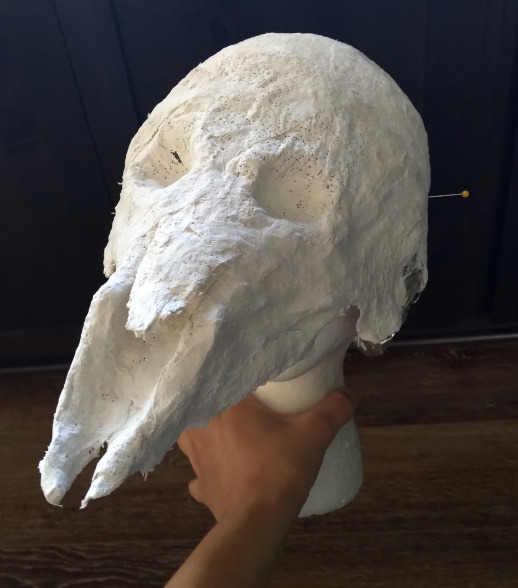
Once that had dried, I cut out holes for the eyes and sculpted horns and ears out of Model Magic -- I thought that it would be light enough to keep this mask wearable, but strong enough to maintain its structural integrity (although I added armature wire into the longer horns for greater stability). The large horns were originally textured by imprinting them with a bamboo sushi rolling mat.
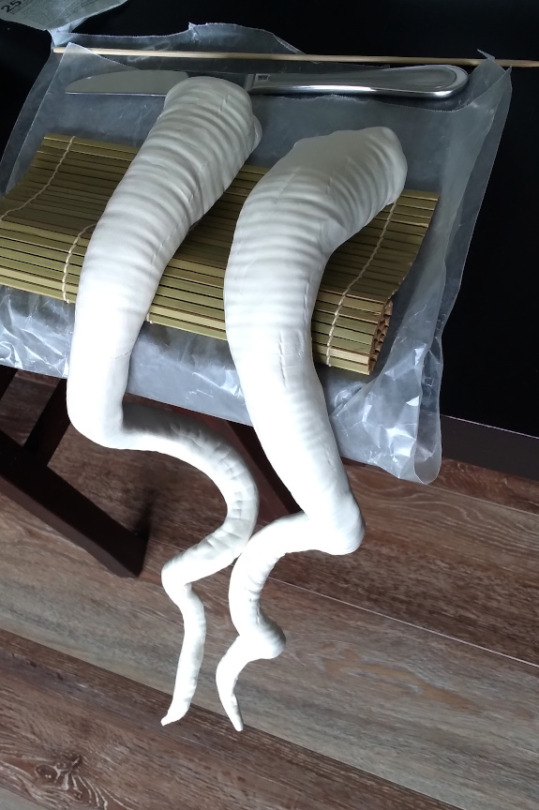
Once the horns and ears had fully dried, I glued them to the mask with Elmer’s Craft Glue and used plaster wrap to more securely tie them in. I also added eyelids, and did a quick test to make sure the mesh “follow-me” eyes fit:

After everything had ostensibly dried, I covered the plaster with papier-mâché to smooth out the surface and to strengthen the mask.

It’s at this point, as the papier-mâché on the inside of the mask was drying, that I realized the large horns weren’t strong enough. Both of them started to break near the base; I originally tried fixing them with toothpicks and glue, but that was not enough. I ended up coating both of them in papier-mâché clay (a mix of paper pulp, drywall joint compound, and flour), which meant that I needed to redo the texture on them -- this time by adding details to the clay with a butter knife. Even after this dried, one of the horns continued to break. I eventually had to wrap the bottom third of each horn in plaster wrap, then papier-mâché over them entirely...which meant I had to retexture them again by adding small rolled-up pieces of plaster wrap.
After much frustration, the mask was finally ready to paint. The original black acrylic paint I used was too glossy, so I recoated it with a matte acrylic...which was too light and dull, so I added a layer of matte Modge Podge. To add more texture to the horns, I used an undercoat of grey paint, then used a fan brush to roughly go over it in black, letting some of the original grey shine through in streaks.

Finally, it was time to add the finishing touches! I attached black suede to the backs of the ears, glued in the buckram mesh eyes, and chose to use feather trim to make the hair/floof/whatever you want to call it. I used a little more Model Magic to make supports onto which I glued the feather trim -- without it, the feathers lay too flat and weren’t floofy enough.
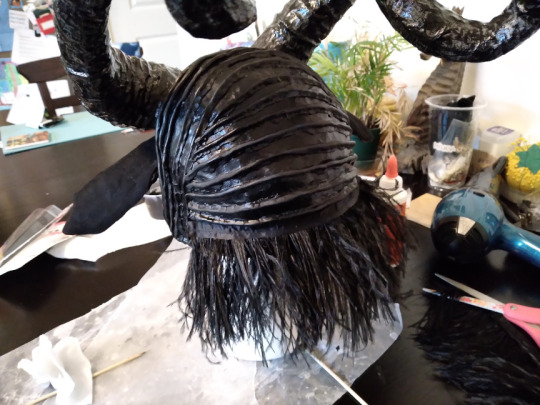
I ended up using E6000 to attach the trim -- since the feathers were sewn into polyester ribbon, I wasn’t sure if it would adhere to craft glue.

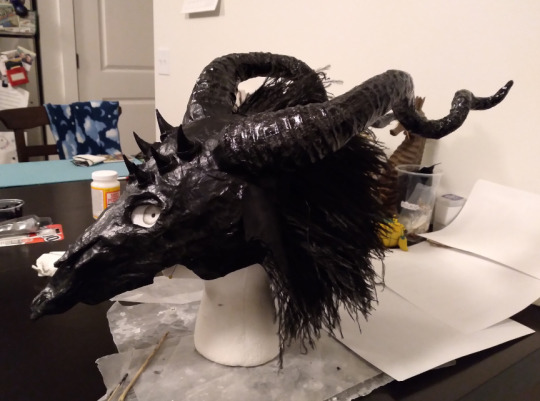
The last steps in making the mask were to smooth out where the trim and suede were attached -- I covered visible lines with papier-mâché, then painted and sealed it once it had dried. I still wasn’t happy with how stark the hairline was, so I glued individual feathers to the top of the mask to soften it.
All that’s left now is to style the feathers.
25 notes
·
View notes
Text
Star Trek is something else. I rewatched Arena last night, and conceptually it's a fine parable about the importance of communication and diplomacy, the perils of retaliation, and the devastating foibles of ignorant colonisation and invasion. It's about how colonisation is still bad, even if you didn't realise it as invasion at the time. That reconciliation is paramount. For a story that aired in a time where Indigenous Australians were still classified as flora and fauna (i.e. not people) in their native country this is astonishingly forward thinking.
We see the episode unfold from the colonists' viewpoints, but little by little we realise the Gorns are fiercely intelligent, even if they look different. They flee when Starfleet kills some of their own, they are chased and nearly get away. We learn that they were not so unprovoked in attacking the outpost.
On the other hand, it's 50 minutes of some poor actor in a rubber lizard suit - draped over which is (for some reason) a pizza apron - and this gorn's throwing bouncy papier mache rocks at William Shatner (who's making like Mulan and creating plastic bamboo bombs), and the episode ends with the reconciliatory appearance of a sparkly, otherworldly, resplendent drag queen.
Honestly, peak tv.
17 notes
·
View notes
Photo

Jared Ginsburg--Setwork III 2020 Wood papier-mache bamboo rubber ink and graphite on paper 119 x 178 x 4.5 cm
25 notes
·
View notes
Photo


Happy New Year!!! Let's hope 2022 is better than the last two years have been! My ani-ME, Kiku, is ready for the New Year! Oshogatsu (the New Year period) is one of the most important holidays of the year in Japan.
The celebration begins in December with bōnenkai, or “forget-the-year” parties, as a means of forgetting the hardships of the past year.
In the photo, you can see a Shimenawa, a sacred straw rope used to indicate a purified space and to protect from evil spirits. Also traditionally hung for the Japanese New Year are oshogatsu kazari (New Year decorations) made of bamboo, pine, and straw. These decorations are hung on the front door of houses or set up at shop entrances to welcome Toshigami (a god that brings good luck in the New Year) and ward off evil spirits. Inside, people display kagami mochi, a two-tiered circular rice cake topped with an orange, as well as ornaments that represent the Chinese zodiac animal for the coming year (for 2022, this is the tiger).
Between Jan. 1-3, people partake in hatsumode, the first shrine visit of the year. It is customary to return the previous year's good luck charms to the shrine and replace them with new ones for the coming year. It is common for people to wear kimonos during hatsumode, which Kiku is doing.
Afterward, families return home and feast on osechi ryori, a gorgeous box consisting of various dishes each with a different meaning. Kiku is showing off one such box in this photo.
Also shown in the photo behind and on either side of Kiku are Kadomatsu (pine gates), which are displayed in pairs at the front of house gates and buildings from Jan. 1-7. They usually consist of three bamboo poles cut diagonally to different lengths with pine tree branches tied to them with straw rope. They may also include sprigs of other foliage and flowers. The bamboo represents growth and strength, while pine is a symbol of longevity.
Other traditions include osoji, which is a meticulous cleaning of the house, work place, school, and neighborhood, making everything completely spotless. Nengajo (postcards) are also sent to relatives, friends, colleagues, and other acquaintances, thanking them for their kindness over the past year and wishing them well for the coming year.New Year's Eve (Dec. 31) in Japan is called Omisoka. At this time, it's customary to eat toshikoshi soba, a special dish made of extra-long buckwheat noodles that symbolize a long life, strength, and resilience.
Hatsuhinode is the first sunrise of the year. Before sunrise on January 1st, people often drive to the coast or climb up a mountain to enjoy the view.
Children are gifted with otoshidama, an envelope of money; fly traditional kites called takoage; and play karuta, a traditional card game. During the New Year period, many people also love to hit the shops to get their hands on a fukubukuro, mystery bags full of goods sold at a discounted price.
Daruma are round and hollow Japanese dolls, modeled after Bodhidharma, the founder of the Zen sect of Buddhism. They are a symbol of perseverance and good luck associated with goal setting, making them popular during the New Year when many people set their resolutions for the coming year. Usually made of papier-mâché, daruma are sold without pupils. The recipient of the doll fills in one pupil upon setting the goal, and then fills in the other when the goal has been achieved successfully. A one-eyed daruma is a reminder of the goal, and helps keep one on track to attaining it.
And so ends today's cultural lesson! In fact it wasn't obvious or already known, I'm very fascinated with Japanese cultures and customs! :D
#My Plastic Life#doll photography#anime doll#ani-ME#Azone International#Azone Pure Neemo#Azone doll#Azone Pure Neemo doll#one sixth scale#Japanese New Year#New Year#Oshogatsu#myfroggystufffanpics#TenderWolf
8 notes
·
View notes
Text
Day 3 - Culture
Ship: RusViet
Word Count: 588
@aphrarepairweek2021
Rain was coming down in torrents; Vietnam exchanged a look with Russia. It looked like they’d be staying indoors for today. The world meeting--being held in London--had let out early on account of nearly everyone showing up hungover due to irresponsible drinking the previous night.
As she considered what they could do, something occurred to her.
“Vanya? You said you wanted to try a drink from my place, didn’t you?” she said.
Russia brightened.
“Oh, yes!” he said. “And if you want to try one of my drinks, Liên, then we can make one for each other!”
Vietnam considered her boyfriend’s idea; while she had had Russian cuisine before, it was mainly in hotels or in restaurants when she visited him. It would be different to have something made by Russia himself.
Besides, not only was cultural sharing important to relations, she was just as interested in Russia’s culture as he was interested in hers. And after lunch--bún măng vịt for her and shchi for Russia--she could go for something to drink. Vietnam nodded.
“Alright,” she said. “How does cà phê đá sound?”
“I’m sure anything you make will be delicious, Liên,” Russia said.
Vietnam blinked, slightly taken aback, and she felt herself lightly blushing. Russia was always kind to her, of course, but she wasn’t known for her cuisine like France or Italy or China were.
“What?” Russia said innocently, tilting his head as he frowned in confusion. “Was it something I said?”
“No, it’s nothing,” Vietnam said, and Russia’s smile returned to his face. “Just--thank you, Vanya.”
Vietnam got to work on the ingredients; behind her, she heard Russia doing the same.
After she finished the drink and put the last touches on the iced coffee, she brought both to the table. The room they were staying in had a kitchenette and a small table. She took a seat, and a few moments later, Russia came over and placed a glass filled with a dark purple liquid in front of her.
“Sbiten,” Russia told her. “It’s based on honey mixed with water, spices, and jam.”
Vietnam took a sip of the sbiten; sweetness exploded over her tongue.
“Cà phê đá is iced coffee,” Vietnam said. “Coffee got its start in my country when a coffee plant was brought into the north.”
She watched as Russia took a drink.
“It’s sweet,” he said. “And tastes a little like chocolate!”
“It has a lot of condensed milk in it,” Vietnam said. “And cacao is sometimes added during the roasting process. How do you like it?”
“It’s very good,” Russia said. “I don’t drink a lot of coffee, but I like this a lot!”
“Thank you,” she said.
“And you?” Russia said. “How do you like sbiten?”
“It’s very sweet,” Vietnam said. Apparently it was a day for sweet drinks. “I like it. And it’s good for a rainy day like this.”
“Yes, it’s always been a drink for the winter months,” Russia said. “It gets cold at my house, you know.”
Something in his expression seemed to shift at that; Vietnam knew Russia didn’t like talking about his own colder weather, because it was part of the reason why he felt so isolated and alone a lot of the time.
After a moment, she spoke up again.
“Maybe you could tell me about me Palekh miniatures,” she suggested. “And if you want, I can tell you about Đông Hồ woodcut painting.”
Russia’s face brightened with a smile.
They spent the rest of the afternoon together, teaching the other about their own art forms.
Notes:
Bún măng vịt - Vietnamese duck noodle soup with bamboo shoots
Shchi - Russian cabbage soup
Cà phê đá - Vietnamese iced coffee
Sbiten - Traditional Russian drink based on honey, water, spices, and jam
Palekh miniatures - Russian folk art handicraft of a miniature painting that orignated in Palekh, done with tempura paints on varnished articles made of papier-mâché
Đông Hồ woodcut painting - Vietnamese folk paitning originating in Đông Hồ
#hetalia#rusviet#otp#vietrus#hws vietnam#hws russia#ivan braginsky#my fic#my writing#my fanfiction#my fanfic#fanfic#fic#fanfiction#aphrarepairweek2021
28 notes
·
View notes
Photo
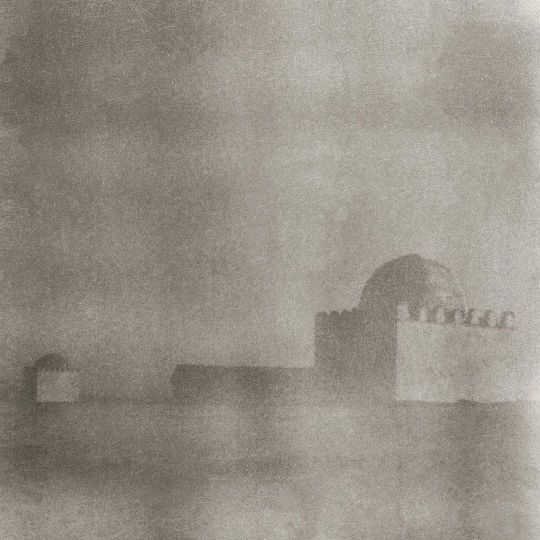
Les deux inséparables, série Le grain de beauté du Saint . Tirage fine-art issu d’un Polaroïd SX70 . 80x80 cm et 40x40 cm sur papier Kozo Awagami Murakumo naturel 1/3 15x15 cm sur papier Bamboo 2/3 . . Exposition à découvrir sur la Mezzanine de la Galerie 127 Marrakech . #morocco #maroc #polaroid #sx70film #photographie #mystic #saint #legraindebeautedusaint #femmephotographe #marrakech @galerie127 @isabelle_ehrler . . Galerie 127 Marrakech Mardi-samedi Horaires ramadan de 11h à 16h (à Galerie 127) https://www.instagram.com/p/CqTvfxvINNU/?igshid=NGJjMDIxMWI=
#morocco#maroc#polaroid#sx70film#photographie#mystic#saint#legraindebeautedusaint#femmephotographe#marrakech
2 notes
·
View notes
Photo

Hat Case, late 19th century, Brooklyn Museum: Asian Art
Size: Case Body: 5 3/4 x 12 1/2 in. (14.6 x 31.8 cm) Case Lid: 1 9/16 x 12 11/16 in. (4 x 32.3 cm) Medium: Papier mache, lacquer, bamboo, silk, lacquer
https://www.brooklynmuseum.org/opencollection/objects/121817
10 notes
·
View notes